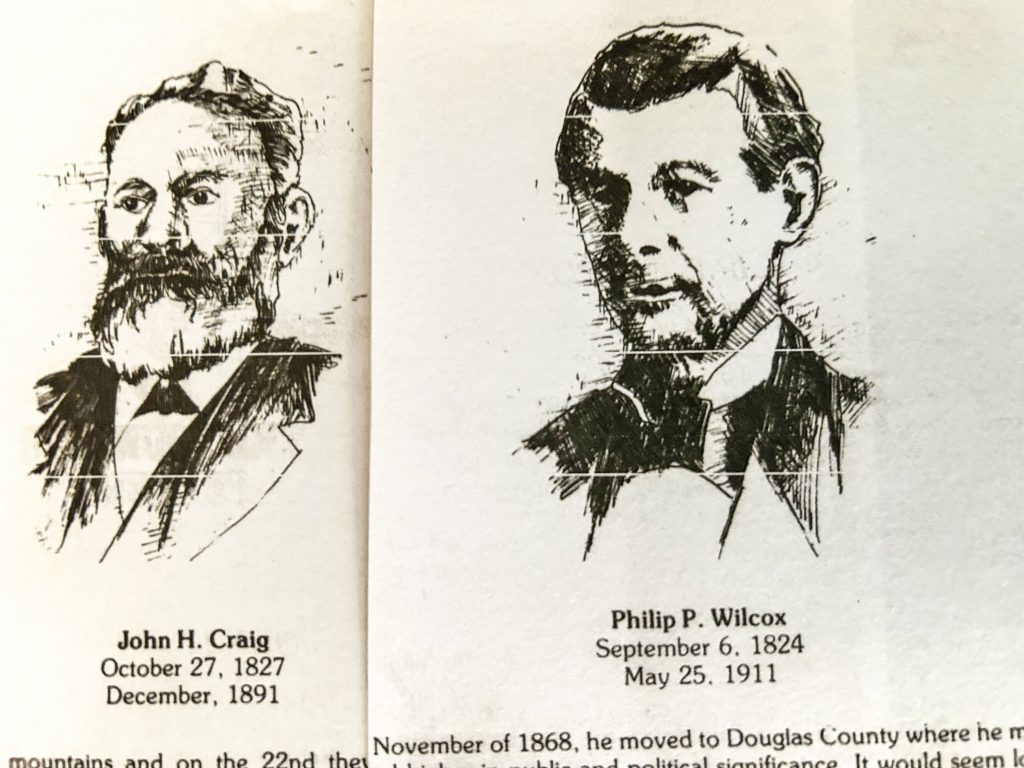Castle Rock’s founding triumvirate

Sketches of John Craig and Philip Wilcox from the book “Castle Rock: A Grass Roots History” by Robert L. Lowenberg.
Shakers and movers are colorful folks, visionaries and risk takers seeing and often seizing opportunities that others will not. Castle Rock’s founders John Craig, Jeremiah Gould and Philip Wilcox were prime examples.
Pennsylvanian John Craig arrived here in 1859. Tragically, he had lost his wife and daughter in the preceding four years. Within the wave of gold prospectors, he first came to the Happy Canyon area joining “Happy” Jack Johnson and Charles Holmes.
Finding no gold, but liking his new Colorado environment, Craig moved southwest, camping at his friend D.C. Oakes’ sawmill on the First Territorial Road (today, Daniels Park Road). Oakes knew of and likely recommended a prime land, the juncture of East and West Plum Creeks. Craig moved quickly, claiming the acreage as his homestead.
By 1865, Craig had proved up his claim, calling it Round Corral. Several name changes later, the property had become the keystone of a town named Sedalia.
Ever restless, Craig wasn’t finished, selling his place to Jonathan House in 1870. Moving to Castle Rock, he purchased land on speculation.
Meanwhile, Rhode Islander and former Union soldier Jeremiah Gould arrived about the same time. He homesteaded 160 acres south of Castle Rock, taking over an existing structure, later named “Uncle Jerry’s Claim Cabin.” He also made a living partnering with Colorado Governor James B. Orman, who traded horses and constructed railroad beds in the area.
Gould, too, had speculated on land. His and Craig’s landholdings were contiguous. Together their parcels would become Castle Rock’s sweet spot. Later chosen as the Douglas County seat in 1874, Gould donated 120 of his 160 acres to the Town of Castle Rock for platting. Craig also contributed acreage.
Latecomer Pennsylvanian Philip P. Wilcox pledged an additional 80 acres. Together, the three platted the early Castle Rock townsite including today’s courthouse square and 100 home parcels.
Wilcox’s contribution and gravitas was already significant, and thus, Castle Rock’s main street was named after him.
A polished influencer, Wilcox was always at the cutting edge of politics, well before Douglas County boundaries were finalized. He had served as an Elbert County attorney, notary public, Douglas County commissioner, County judge and later Douglas County attorney. By 1877, he had been appointed as a U.S. Marshal for the State of Colorado.
Wilcox’s deft manipulation of power led to a nickname, “Pike’s Peak” or “P.P.” for short. Wilcox had opinions that were generally voiced vigorously and carried great weight. When New Memphis leaders publicly slandered Castle Rock in the race to become County seat, old P.P. suggested that the “whiskey (in New Memphis) was good, but not the water.”
Craig was elected to the Colorado House of Representatives and later, mayor of Castle Rock from 1886-1891. Days before his 64th birthday, he succumbed to pneumonia.
Gould later built and managed a hotel, the Narragansett, in Denver. At age 65 in 1903, a tumbling newspaper page spooked his horse. Bucked violently to the ground, he died nine months later.
P.P. lived to age 77, battling frequently with Native Americans, among them Geronimo, who refused to be peacefully subdued. For all the power he commanded, P.P.’s investment skills were wanting. When he died, his personal fortune had all but disappeared.
By Joe Gschwendtner; courtesy images